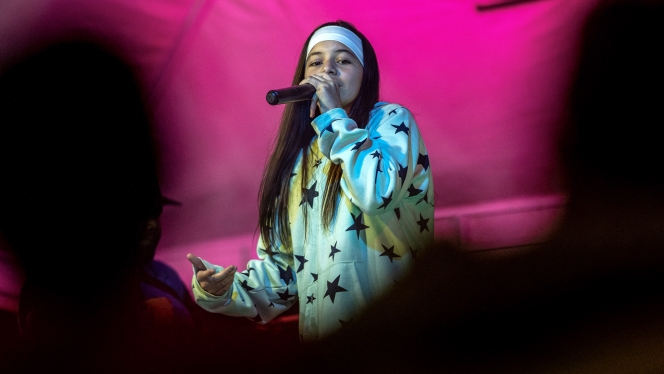Lot 18. Pierre Soulages (Né en 1919), Peinture 81 x 54 cm, 16 juin 1951, signé'Soulages' (en bas à droite); signé de nouveau et situé'SOULAGES 11 bis Rue Schoelcher PARIS 14' (au revers), huile sur toile, 81 x 54 cm. Peint le 16 juin 1951 à Paris. Estimate EUR 500,000 - EUR 700,000. Price realised EUR 631,500. © Christie's Images Ltd 2017
signed 'Soulages' (lower right); signed again and located 'SOULAGES 11 bis Rue Schoelcher PARIS 14' (on the reverse), oil on canvas, 31 7/8 x 21 ¼ in. Painted on the 16th of June 1951 in Paris.
Provenance: Collection George David Thompson, Pittsburgh (acquis en 1953).
Collection particulière, Grande-Bretagne (acquis en 1960).
Puis par descendance au propriétaire actuel.
Literature: P. Encrevé, Soulages. L'œuvre complet. Peintures, Paris, 1994, vol. I, p. 128, no. 80 (illustré).
Exhibited: Copenhague, Galerie Birch, Soulages, août-septembre 1951.
Pierre Soulages dans son atelier, rue Schoelcher, en 1951. Photographie anonyme. © ADAGP, Paris, 2017.
« Une peinture est un tout organisé, un ensemble de relations entre des formes (lignes, surfaces colorées...) sur lequel viennent se faire ou se défaire les sens qu’on lui prête. »
'‘A painting is an organization, a set of relationships between shapes (lines, colored surfaces, etc.), on which the meanings which we give it are made and undone.''
Pierre Soulages.
Le tournant des années 1950 constitue une période charnière dans la trajectoire artistique de Pierre Soulages. Sa toute première exposition personnelle chez Lydia Conti à Paris en 1949 est immédiatement remarquée par la presse et, quelques mois plus tard, le musée de Grenoble devient la première institution à faire entrer l’une ses toiles dans une collection publique. Très tôt, son travail acquiert une solide reconnaissance outre-Atlantique. James Johnson Sweeney, alors conservateur au MoMa, sort enchanté de la visite de l’atelier de Soulages rue Schoelcher en 1948, alors que Leo Castelli l’inclut dans l’exposition Young Painters in US & France qu’il organise à la Sidney Janis Gallery en 1950, mettant ses œuvres en parallèle de celles de Franz Kline. L’année suivante, les peintures de Soulages sont exposées dans les musées américains de Washington, San Francisco, Chicago et Baltimore à l’occasion de l’exposition itinérante Advancing French Art.
Ce n’est donc pas un hasard si le premier propriétaire de Peinture 81 x 54 cm, 16 juin 1951 a été un célèbre collectionneur américain, George David Thompson, important donateur du Carnegie Museum of Art de Pittsburgh, qui aura tout au long de sa vie amassé une collection de plus de 600 œuvres d’art, allant de Paul Klee, Pablo Picasso, Alberto Giacometti ou Henry Moore à Adolph Gottlieb, Josef Albers, Jean Dubuffet ou Willem de Kooning. Son ensemble de 70 œuvres de Giacometti a été acquis par l’intermédiaire d’Ernst Beyeler pour enrichir par la suite les collections du Kunsthaus Zürich, du Kunstmuseum de Bâle et du Kunstmuseum Winterthur ; tandis que sa collection d’œuvres de Paul Klee est devenue le noyau constitutif du Kunstsammlung Nordrhein-Westfalen de Düsseldorf. Membre de conseil d’administration du MoMA, George David Thompson a dû suivre de près l’acquisition de Peinture 146 x 97 cm, 10 janvier 1951 par le musée en 1952, une œuvre qui frappe par sa ressemblance avec Peinture 81 x 54 cm, 5 mai 1951, l’œuvre qu’il choisit alors pour sa propre collection.
Peinture 81 x 54 cm, 16 juin 1951 se révèle un exemple précoce du style emblématique de Soulages qui se formalise au cours de ces années décisives. Elle est également révélatrice du parti pris de l’artiste de mettre en valeur le noir si caractéristique de son œuvre. La lumière surgit ici du contraste réalisé entre le fond bleu et gris du tableau et les larges aplats d’huile noire épaisse qui scandent la toile de façon orthogonale et lui confèrent sa monumentalité. La vive opposition des couleurs, en petites surfaces fortement contrastées, engendre un effet de « clignotement lumineux », évoquant un vitrail gothique, une importante source d’inspiration pour Soulages, tandis que l’association du bleu et le noir profond renvoie à des recherches spatiales entreprises par Pierre Matisse un demi-siècle plutôt dans Intérieur, bocal de poissons rouges de 1914. Soulages entend ainsi renouveler dans Peinture 81 x 54 cm, 16 juin 1951 sa propre approche de la spatialité du tableau et des jeux de transparences qui s’y produisent. L’historien Charles Estienne évoquera en ces termes éloquents la peinture de Soulages de cette période : « un graphisme simple, viril, presque rude, des harmonies sombres et chaudes, un sens naturel de la pâte et des possibilités spécifiques de la peinture à l’huile, et surtout peut-être un son à la fois humain et concret, voilà l’apport de Soulages à la peinture abstraite actuelle.» (cité in P. Encrevé, Soulages, L'Œuvre complet - Peintures, Vol. I, 1946-1959, Paris, 1994, p. 169).
Pierre Soulages, Peinture 146 x 97 cm, 10 janvier 1951. The Museum of Modern Art, New York. © ADAGP, Paris, 2017.
Pierre Soulages’ artistic career really began to take of at the turn of the 1950s. His frst solo exhibition at the Galerie Lydia Conti in Paris in 1949 made an immediate impression on the press and, a few months later, the Musée de Grenoble became the first institution to include one of his paintings in a public collection. Before long, he had gained a solid reputation for his work on the other side of the Atlantic. In 1948, James Johnson Sweeney, at the time curator for MoMA, visited Soulages’ studio in Rue Schoelcher and left thrilled by what he had seen. In 1950, Leo Castelli included him in theexhibition Young Painters in US & France that he was organizing at the Sidney Janis Gallery, putting his works in parallel with those of Franz Kline. The following year Soulages’ paintings were shown in the American museums of Washington, San Francisco, Chicago and Baltimore as part of the travelling exhibition Advancing French Art.
It should therefore come as no surprise that the first owner of Peinture 81 x 54 cm, 16 juin 1951 was the noted American collector George David Thompson, who was also an important donor to the Carnegie Museum of Art in Pittsburgh. Over the course of his life he collected more than six hundred works of art, the collection including works by Paul Klee, Pablo Picasso, Alberto Giacometti, Henry Moore, Adolph Gottlieb, Josef Albers, Jean Dubufet and Willem de Kooning. His collection of seventy works by Giacometti was acquired by Ernst Beyeler to subsequently enrich the collections of the Kunsthaus Zürich, the Kunstmuseum Basel and the Kunstmuseum Winterthur; while his collection of works by Paul Klee came to form the core exhibit of the Kunstsammlung Nordrhein-Westfalen in Düsseldorf. George David Thompson, a member of the Board of Trustees of MoMA, closely monitored the acquisition of Soulages’s Peinture 146 x 97 cm, 10 janvier 1951 by the museum in 1952, a work striking in its resemblance to Peinture 81 x 54 cm, 16 juin 1951, the work he then chose for his own collection.
Peinture 81 x 54 cm, 16 juin 1951 proved to be an early example of Soulages’ iconic style that was taking shape during those decisive years. It also reveals the artist’s predilection for making black stand out, the key characteristic of his work. Here, light emanates from the contrast between the painting’s blue and grey background and the wide fat areas of thick black paint that mark the canvas orthogonally and give it its monumentality. The distinct variance of colours in small, highly contrasted areas creates a ‘fashing light’ efect, evoking a Gothic stained glass window, an important source f inspiration for Soulages; while the combination f blue and deep black recalls the spatial studies undertaken by Pierre Matisse half a century earlier in Intérieur, bocal de poissons rouges, 1914. It seems then that, in Peinture 81 x 54 cm, 16 juin 1951, Soulages wanted to try a new approach to spatiality in the painting and to the play of transparencies produced. The historian Charles Estienne eloquently evokes for us Soulages’ painting from this period: “simple, virile graphics, gritty almost; dark, warm harmonies; a natural understanding of texture and of the specifc possibilities of painting with oil; and above all, perhaps, a tone that is both human and concrete: here is Soulages’ contribution to contemporary abstract painting.” (cited in P. Encrevé, Soulages, L’OEuvre complet - Peintures, Vol. I, 1946-1959, Paris, 1994, p. 169).
Christie's. Paris Avant-Garde, 19 October 2017, Paris





























































